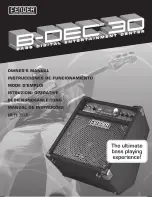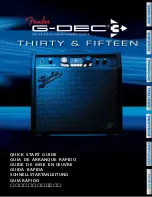
19
EN
IT
DZ802
CHOOSING THE RIGHT AMPLIFIER
AES long term applicable power denotes the thermal
power that can be dissipated by the loudspeaker or by
the individual drivers when operated in BI-AMP mode.
This value is measured in accordance with the AES
standard, which involves a 2 hour test with pink noise
signal, crest factor of 2. Power is determined by the
square of the RMS voltage divided by the minimum im-
pedance of the loudspeaker or the individual driver. Al-
though the power of the recommended amplifier is not
measured, it is equivalent to double the AES power val-
ue and it takes account of the dynamic capacities of the
speakers to withstand short duration power peaks. The
value supplied corresponds to the RMS power required
of the amplifier in order to supply the test signal (pink
noise with crest factor 2) utilised to measure AES power.
An amplifier of this power, if used with music signals
with crest factor greater than or equal to 6dB, makes it
possible to get the best performance out of the speaker,
delivering along term power output that is no higher
than the AES power of the loudspeaker. On the contrary,
when using highly compressed music signals or if the
amplifier volume is increased to the point of intensive
clipping, then the effective long term power tends to
reach or even exceed the RMS output of the amplifier,
resulting in irreversible damage to the speakers. With
signals of this type it is always advisable to use an ampli-
fier whose RMS output is identical to the speaker AES
power, while taking care to ensure that the signal sup-
plied is such that the amplifier is not caused to function
in clipping mode too frequently IEC268-5 short term ap-
plicable power corresponds to the power that the loud-
speaker can withstand for a very short time interval.
This value corresponds to 4 times the AES power value
and it is calculated on the basis of the maximum peak
voltage that the recommended amplifier can supply to
the loudspeaker. Capacities in terms of SPL in transient
components of music signals, effectively correspond to
the short term applicable power value; therefore, the
max. SPL value specified in the technical specifications
table is calculated on the basis of this power value Warn-
ing: the power value that effectively corresponds to the
thermal capacity of the loudspeaker to dissipate electri-
cal energy over the long term is represented by the AES
value. All other values refer to the “transient capacity”
of the loudspeaker to accept power inputs, correlated
with the nature of the audio signal that the drivers are
destined to reproduce.
COME SCEGLIERE L’AMPLIFICATORE
La potenza di lungo termine AES, rappresenta la poten-
za termica dissipabile dal diffusore o dai singoli alto-
parlanti, viene misurata secondo lo standard AES, che
prevede un test di 2 ore con segnale pink noise, fattore
di cresta 2 ; la potenza viene determinata dalla tensio-
ne RMS al quadrato divisa per l’impedenza minima del
diffusore o del singolo altoparlante. La potenza dell’am-
plificatore consigliato non viene misurata, ma è pari al
doppio della potenza AES e tiene conto delle capacità
dinamiche degli altoparlanti di sopportare picchi di po-
tenza per brevi istanti di tempo. Il valore fornito corri-
sponde alla potenza RMS che l’amplificatore deve avere
per fornire il segnale di test ( pink noise con fattore di
cresta 2) usato per misurare la potenza AES.
Un amplificatore con tale potenza, se usato con segnali
musicali con fattore di cresta maggiore o uguale a 6dB,
permette di ottenere il massimo delle prestazioni del
diffusore, erogando una potenza di lungo periodo non
superiore a quella AES del diffusore. Se, viceversa, si usa-
no segnali musicali molto compressi o il volume viene
alzato fino al punto da spingere fortemente in clipping
l’amplificatore, allora, la potenza effettiva di lungo perio-
do erogata, tende a raggiungere o addirittura superare
quella RMS dell’amplificatore, danneggiando in modo
irreparabile gli altoparlanti. Con questo tipo di segnale
è consigliabile usare un amplificatore con potenza RMS
pari alla potenza AES del diffusore, facendo comunque
attenzione a non fornire un segnale di ampiezza tale
da portare troppo spesso in clipping l’amplificatore. La
potenza di breve termine IEC268-5 è la potenza che il
diffusore può sopportare per un brevissimo intervallo di
tempo. Corrisponde a 4 volte la potenza AES e viene cal-
colata in base alla massima tensione di picco che l’am-
plificatore consigliato può fornire al diffusore. Le capaci-
tà in termine di SPL nei transitori del segnale musicale,
sono effettivamente corrispondenti a tale valore; quindi
il dato di SPL max fornito nella tabella delle specifiche
tecniche viene calcolato in base a tale valore di potenza.
Attenzione: il dato di potenza che effettivamente corri-
sponde alle capacità termiche del diffusore di dissipare
potenza elettrica per lungo periodo è quella AES. Tutti
gli altri dati si riferiscono a “capacità transitorie” del dif-
fusore di accettare potenze correlate con la natura del
segnale audio che sono destinate a riprodurre.


































